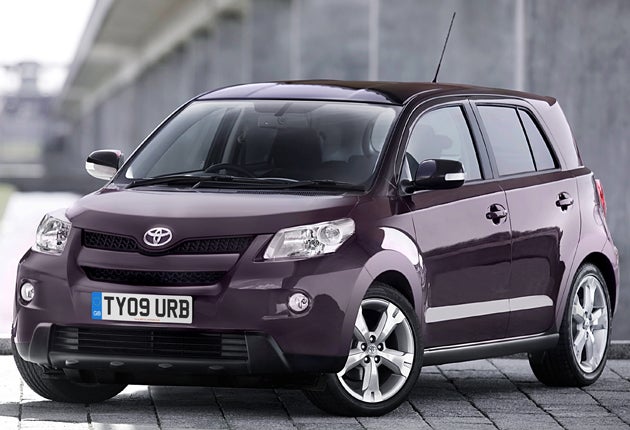Toyota Urban Cruiser
Toyota's new mini multi-purpose vehicle looks the part – but it's expensive, has a small engine, and lacks versatility

It's a crossover. We've seen these before, I believe. The idea is to mix some visual and proportional attributes of an SUV with the convenience and simplicity of a hatchback, and create something not overly aggressive but somehow suited to the role of protective transport capsule in the urban warzone.
That such cars exist is a sad indictment of life-stress in the modern metropolis, but there we are. It's good to know your car looks like it can clamber over barricades and urban debris when the social fabric crumbles.
We shouldn't need cars like this. They suggest a failure of civilisation. But maybe I'm over-analysing. After all, Toyota merely says its new Urban Cruiser is "targeting customers with active lifestyles", which is hardly an original line. Couch potatoes not allowed, then. I'll start looking for the skateboard-holder right now.
You do get a whiff of a notion that Toyota GB's heart isn't entirely in this car, though. The information pack copywriter was clearly struggling when he or she extolled the virtues of the maintenance-free, self-adjusting clutch, a feature common to virtually every manual transmission car made today. However, the petrol version has another, cleverer clutch.
It is part of the stop-start system which, as is usual, stops the engine when the car is stationary, in neutral and the clutch pedal is up. In the Urban Cruiser's little 1.3-litre motor, the starter motor always stays engaged with its ring gear, saving precious milli-seconds when restarting is required, but the ring gear is itself decoupled from the engine's flywheel by an instantly engagable clutch. Clever.
It works well, with near-instant restarting when you depress the clutch pedal. The engine, though quiet, is less impressive once running because despite its 101bhp it feels daunted by the task of hauling a car which, while supposedly in the super-mini class, is really quite a hefty lump. Sixth gear on a motorway incline is futile.
Fortunately, there's a 1.4-litre diesel alternative for an even more optimistic price, £16,400 instead of £14,500. The extra outlay also includes a four-wheel drive system to give the Urban Cruiser the tractive ability to match its looks; it's the sort that is front-wheel drive most of the time, sending energy to the rear wheels only when the fronts start to slip. The diesel Urban Cruiser cruises with much less effort, thanks to the easy thrust typical of the engine type; its power output is less (90bhp) but its pulling ability is much greater, leading to identical top-speed and 0-62mph figures but producing them more restfully. Its official CO2 is slightly worse (130g/km against the petrol's impressive 129), but in reality it will be better.
But you won't be buying an Urban Cruiser for how it feels to drive. It's quite comfortable over bumps and it goes where you point it, but the steering has the resistant, artificial feel at speed found in many electrically powered systems and there's little interactive pleasure to be gained. If you bought a Cruiser it might instead be for the butch wheel arches, the tall sides that look like they would protect you from all hostile streetlife, the faux-4x4 undertrays and big bumpers, the slender, gun-turret-like side windows.
If that's your game, you need to add the Urban Pack which clads the arches, sills and bumper corners in black plastic the better to stave off scuffs in "the knocks and scrapes of modern urban driving" (if you're careless, anyway). Other packs are Style (pieces of bright metal embellishment) and Tech (various USB and MP3 interfaces including one for an iPhone). Sat-nav and leather trim are also optional.
Which brings me to the interior. You sit quite high, of course; that's a key point of a car like this. There are plenty of places to put things including two stacked gloveboxes. The reclining rear seats can be slid back and forth to alter the legroom-to-luggage ratio (not that the Urban Cruiser can ever be called roomy), but with the backrests folded down there's quite a step up from boot floor to your new load-bay extension.
It's all quite calm and conventional in here, the chief point of interest being the three-segment instrument panel whose central dial has the speedo-meter around most of the periphery and the rev counter occupying the remaining sector. As with many new cars, a gearshift indicator shows when a change of ratio might improve economy. There's also a keyless entry system and a push-button starter.
In the end, though, I can't get too excited about the Urban Cruiser. It costs more than similar toughened-up mini-MPVs (for that is what it is), yet has a smaller engine and less versatility (no underfloor storage, for example). If you want a small Toyota with four seats, buy a Yaris instead.
The Rivals
Citroën C3 Picasso 1.4 Exclusive: £13,695
Top-trim version undercuts Toyota while offering more space, more usefulness and a comfortable ride.
Kia Soul 1.6 Shaker: £12,495
Kia's take on an 'urban', quasi-military mini-MPV, the Soul Shaker looks fun, is roomy and good value, but has sticky steering and is noisy at speed.
Nissan Note 1.4 Acenta: £11,640
Fewer frills and a lower price, but the Note is very well finished, has lots of space, and is the most rewarding to drive of all. An undiscovered gem.
Join our commenting forum
Join thought-provoking conversations, follow other Independent readers and see their replies
Comments
Bookmark popover
Removed from bookmarks